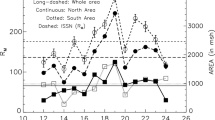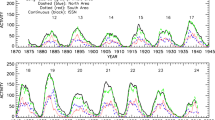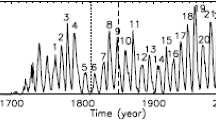Abstract
In most of the solar cycles, activity in the northern and southern hemispheres peaks at different times. One hemisphere peaks well before the other, and at least one of the hemispheric maxima frequently does not coincide with the whole sphere maximum. Prediction of the maximum of a hemisphere and the corresponding north–south asymmetry of a solar cycle may help to understand the mechanisms of the solar cycle, the solar-terrestrial relationship, and solar-activity influences on space weather. Here we analysed the sunspot-group data from the Greenwich Photoheliographic Results (GPR) during 1874 – 1976 and Debrecen Photoheliographic Data (DPD) during 1977 – 2017 and studied the cycle-to-cycle variations in the values of 13-month smoothed monthly mean sunspot-group area in the whole sphere (WSGA), northern hemisphere (NSGA), and southern hemisphere (SSGA) at the epochs of maxima of Sunspot Cycles 12 – 24 and at the epochs of maxima of WSGA, NSGA, and SSGA Cycles 12 – 24 (note that solar-cycle variation of a parameter is expressed as a cycle of that parameter). The cosine fits to the values of WSGA, NSGA, and SSGA at the maxima of sunspot, WSGA, NSGA, and SSGA Cycles 12 – 24, and to the values of the corresponding north–south asymmetry, suggest the existence of a ≈132-year periodicity in the activity of the northern hemisphere, a 54 – 66-year periodicity in the activity of the southern hemisphere, and a 50 – 66 year periodicity in the north–south asymmetry in activity at all the aforementioned epochs. By extrapolating the best-fit cosine curves we predicted the amplitudes and the corresponding north–south asymmetry of the 25th WSGA, NSGA, and SSGA cycles. We find that on average Solar Cycle 25 in sunspot-group area would be to some extent smaller than Solar Cycle 24 in sunspot-group area. However, by inputting the predicted amplitudes of the 25th WSGA, NSGA, and SSGA cycles relationship between sunspot-group area and sunspot number we find that the amplitude (\(130\pm 12\)) of Sunspot Cycle 25 would be slightly larger than that of reasonably small Sunspot Cycle 24. Still it confirms that the beginning of the upcoming Gleissberg cycle would take place around Solar Cycle 25. We also find that except at the maximum of NSGA Cycle 25 where the strength of activity in the northern hemisphere would be dominant, the strength of activity in the southern hemisphere would be dominant at the maximum epochs of the 25th sunspot, WSGA, and SSGA cycles.















Similar content being viewed by others
Data Availability
All data generated or analysed during this study are included in this article.
References
Ahluwalia, H.S.: 2022, Forecast for sunspot cycle 25 activity. Adv. Space Res. 69, 794. DOI. ADS.
Baranyi, T., Győri, L., Ludmány, A.: 2016, On-line tools for solar data compiled at the Debrecen observatory and their extensions with the Greenwich sunspot data. Solar Phys. 291, 3081. DOI. ADS.
Bhowmik, P., Nandy, D.: 2018, Prediction of the strength and timing of sunspot cycle 25 reveal decadal-scale space environmental conditions. Nat. Commun. 9, 5209. DOI. ADS.
Cameron, R.H., Jiang, J., Schüssler, M.: 2016, Solar cycle 25: Another moderate cycle? Astrophys. J. Lett. 823, L22. DOI. ADS.
Carbonell, M., Oliver, R., Ballester, J.L.: 1993, On the asymmetry of solar activity. Astron. Astrophys. 274, 497. ADS.
Chowdhury, P., Gokhale, M.H., Singh, J., Moon, Y.-J.: 2016, Mid-term quasi-periodicities in the CaII-K plage index of the Sun and their implications. Astrophys. Space Sci. 361, 54. DOI. ADS.
Coban, G.C., Raheem, A.-u., Cavus, H., Asghari-Targhi, M.: 2021, Can solar cycle 25 be a new dalton minimum? Solar Phys. 296, 156. DOI. ADS.
Deng, L.H., Xiang, Y.Y., Qu, Z.N., An, J.M.: 2016, Systematic regularity of hemispheric sunspot areas over the past 140 years. Astron. J. 151, 70. DOI. ADS.
Dikpati, M., Gilman, P.A., de Toma, G.: 2008, The Waldmeier effect: An artifact of the definition of wolf sunspot number? Astrophys. J. Lett. 673, L99. DOI. ADS.
Du, Z.: 2020, Predicting the amplitude of solar cycle 25 using the value 39 months before the solar minimum. Solar Phys. 295, 147. DOI. ADS.
Gao, P.X.: 2016, Long-term trend of sunspot numbers. Astrophys. J. 830, 140. DOI. ADS.
Gnevyshev, M.N., Ohl, A.I.: 1948, On the 22-year cycle of solar activity. Astron. Zh. 25, 18.
Gopalswamy, N., Mäkelä, P., Yashiro, S., Akiyama, S.: 2018, Long-term solar activity studies using microwave imaging observations and prediction for cycle 25. J. Atmos. Solar-Terr. Phys. 176, 26. DOI. ADS.
Győri, L., Baranyi, T., Ludmány, A.: 2011, Photospheric data programs at the Debrecen Observatory. In: Prasad Choudhary, D., Strassmeier, K.G. (eds.) Physics of Sun and Star Spots, IAU Symp. 273, Cambridge University Press, Cambridge, 403. DOI. ADS.
Győri, L., Ludmány, A., Baranyi, T.: 2017, Comparative analysis of Debrecen sunspot catalogues. Mon. Not. Roy. Astron. Soc. 465, 1259. DOI. ADS.
Hathaway, D.H.: 2015, The solar cycle. Liv. Rev. Solar Phys. 12, 4. DOI. ADS.
Javaraiah, J.: 2007, North-South asymmetry in solar activity: Predicting the amplitude of the next solar cycle. Mon. Not. Roy. Astron. Soc. 377, L34. DOI. ADS.
Javaraiah, J.: 2008, Predicting the amplitude of a solar cycle using the North-South asymmetry in the previous cycle: II. An improved prediction for solar cycle 24. Solar Phys. 252, 419. DOI. ADS.
Javaraiah, J.: 2015, Long-term variations in the North-South asymmetry of solar activity and solar cycle prediction, III: Prediction for the amplitude of solar cycle 25. New Astron. 34, 54. DOI. ADS.
Javaraiah, J.: 2017, Will solar cycles 25 and 26 be weaker than cycle 24? Solar Phys. 292, 172. DOI. ADS.
Javaraiah, J.: 2019, North-South asymmetry in solar activity and solar cycle prediction, IV: Prediction for lengths of upcoming solar cycles. Solar Phys. 294, 64. DOI. ADS.
Javaraiah, J.: 2020, Long-term periodicities in North-South asymmetry of solar activity and alignments of the giant planets. Solar Phys. 295, 8. DOI. ADS.
Javaraiah, J.: 2021, North-South asymmetry in solar activity and Solar Cycle prediction, V: Prediction for the North-South asymmetry in the amplitude of Solar Cycle 25. Astrophys. Space Sci. 366, 16. DOI. ADS.
Javaraiah, J., Bertello, L., Ulrich, R.K.: 2005, Long-term variations in solar differential rotation and sunspot activity. Solar Phys. 232, 25. DOI. ADS.
Javaraiah, J., Gokhale, M.H.: 1997, Periodicities in the North-South asymmetry of the solar differential rotation and surface magnetic field. Solar Phys. 170, 389. DOI. ADS.
Jiang, J., Wang, J.-X., Jiao, Q.-R., Cao, J.-B.: 2018, Predictability of the solar cycle over one cycle. Astrophys. J. 863, 159. DOI. ADS.
Knaack, R., Stenflo, J.O., Berdyugina, S.V.: 2004, Periodic oscillations in the North-South asymmetry of the solar magnetic field. Astron. Astrophys. 418, L17. DOI. ADS.
Kumar, P., Nagy, M., Lemerle, A., Karak, B.B., Petrovay, K.: 2021, The polar precursor method for solar cycle prediction: Comparison of predictors and their temporal range. Astrophys. J. 909, 87. DOI. ADS.
Labonville, F., Charbonneau, P., Lemerle, A.: 2019, A dynamo-based forecast of solar cycle. Solar Phys. 294, 82. DOI. ADS.
Li, K.J., Wang, J.X., Xiong, S.Y., Liang, H.F., Yun, H.S., Gu, X.M.: 2002, Regularity of the North-South asymmetry of solar activity. Astron. Astrophys. 383, 648. DOI. ADS.
Mandal, S., Banerjee, D.: 2016, Sunspot sizes and the solar cycle: Analysis using Kodaikanal white-light digitized data. Astrophys. J. Lett. 830, L33. DOI. ADS.
McIntosh, S.W., Leamon, R.J., Gurman, J.B., Olive, J.-P., Cirtain, J.W., Hathaway, D.H., Burkepile, J., Miesch, M., Markel, R.S., Sitongia, L.: 2013, Hemispheric asymmetries of solar photospheric magnetism: Radiative, particulate, and heliospheric impacts. Astrophys. J. 765, 146. DOI. ADS.
Muraközy, J., Ludmány, A.: 2012, Phase lags of solar hemispheric cycles. Mon. Not. Roy. Astron. Soc. 419, 3624. DOI. ADS.
Nagovitsyn, Y.A., Osipova, A.A., Nagovitsyna, E.Y.: 2021, “Generative” indices of sunspot solar activity: 145-year composite series. Solar Phys. 296, 32. DOI. ADS.
Nandy, D.: 2021, Progress in solar cycle predictions: Sunspot cycles 24–25 in perspective. Solar Phys. 296, 54. DOI. ADS.
Nepomnyashchikh, A., Mandal, S., Banerjee, D., Kitchatinov, L.: 2019, Can the long-term hemispheric asymmetry of solar activity result from fluctuations in dynamo parameters? Astron. Astrophys. 625, A37. DOI. ADS.
Norton, A.A., Charbonneau, P., Passos, D.: 2014, Hemispheric coupling: Comparing dynamo simulations and observations. Space Sci. Rev. 186, 251. DOI. ADS.
Norton, A.A., Gallagher, J.C.: 2010, Solar-cycle characteristics examined in separate hemispheres: Phase, Gnevyshev gap, and length of minimum. Solar Phys. 261, 193. DOI. ADS.
Pesnell, W.D.: 2018, Effects of version 2 of the international sunspot number on naïve predictions of solar cycle 25. Space Weather 16, 1997. DOI. ADS.
Pesnell, W.D., Schatten, K.H.: 2018, An early prediction of the amplitude of solar cycle 25. Solar Phys. 293, 112. DOI. ADS.
Petrovay, K.: 2020, Solar cycle prediction. Liv. Rev. Solar Phys. 17, 2. DOI. ADS.
Petrovay, K., Nagy, M., Gerják, T., Juhász, L.: 2018, Precursors of an upcoming solar cycle at high latitudes from coronal green line data. J. Atmos. Solar-Terr. Phys. 176, 15. DOI. ADS.
Pishkalo, M.I.: 2021, Prediction of solar cycle 25: Maximum in the N- and S-hemispheres. Kinemat. Phys. Celest. Bodies 37, 27. DOI. ADS.
Ravindra, B., Chowdhury, P., Javaraiah, J.: 2021, Solar-cycle characteristics in Kodaikanal sunspot area: North-South asymmetry, phase distribution and Gnevyshev gap. Solar Phys. 296, 2. DOI. ADS.
Ravindra, B., Javaraiah, J.: 2015, Hemispheric asymmetry of sunspot area in solar cycle 23 and rising phase of solar cycle 24: Comparison of three data sets. New Astron. 39, 55. DOI. ADS.
Rigozo, N.R., Souza Echer, M.P., Evangelista, H., Nordemann, D.J.R., Echer, E.: 2011, Prediction of sunspot number amplitude and solar cycle length for cycles 24 and 25. J. Atmos. Solar-Terr. Phys. 73, 1294. DOI. ADS.
Schüssler, M., Cameron, R.H.: 2018, Origin of the hemispheric asymmetry of solar activity. Astron. Astrophys. 618, A89. DOI. ADS.
Upton, L.A., Hathaway, D.H.: 2018, An updated solar cycle 25 prediction with AFT: The modern minimum. Geophys. Res. Lett. 45, 8091. DOI. ADS.
Verma, V.K.: 1993, On the North-South asymmetry of solar activity cycles. Astrophys. J. 403, 797. DOI. ADS.
Werner, R., Guineva, V.: 2020, Forecasting sunspot numbers for solar cycle 25 using autoregressive models for both hemispheres of the Sun. C. R. Acad. Bulgare Sci. 73, 82. DOI.
Zolotova, N.V., Ponyavin, D.I., Arlt, R., Tuominen, I.: 2010, Secular variation of hemispheric phase differences in the solar cycle. Astron. Nachr. 331, 765. DOI. ADS.
Acknowledgements
The author thanks the anonymous reviewer for useful comments and suggestions. The author acknowledges the work of all the people who contribute to and maintain the GPR and DPD Sunspot databases. The sunspot-number data are provided by WDC-SILSO, Royal Observatory of Belgium, Brussels.
Author information
Authors and Affiliations
Corresponding author
Ethics declarations
Conflict of Interest
The author declares that he has no conflicts of interest.
Additional information
Publisher’s Note
Springer Nature remains neutral with regard to jurisdictional claims in published maps and institutional affiliations.
J. Javaraiah formerly worked at the Indian Institute of Astrophysics, Bengaluru-560 034, India.
Rights and permissions
About this article
Cite this article
Javaraiah, J. Long-Term Variations in Solar Activity: Predictions for Amplitude and North–South Asymmetry of Solar Cycle 25. Sol Phys 297, 33 (2022). https://doi.org/10.1007/s11207-022-01956-z
Received:
Accepted:
Published:
DOI: https://doi.org/10.1007/s11207-022-01956-z




